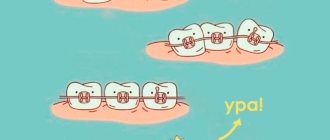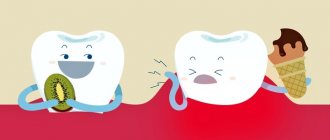Content:
- Why is the position of teeth in a row disturbed?
- Can a crooked tooth fall back into place?
- Consequences of crooked teeth in children
- When should you go to the dentist?
- Devices for correcting uneven teeth
- Prevention Tips
Uneven teeth in children are not only an aesthetic defect. Unfortunately, dental problems can have serious consequences. These include: eating disorders due to improperly chewed food, dysarthria, caries. Due to the uneven arrangement of units in the dentition, plaque accumulates on the enamel due to insufficient hygiene. This leads to the proliferation of pathogenic bacteria, which provokes the formation of caries. That is why you should be careful about your teeth from an early age. My child has uneven teeth, what should I do? It is necessary to visit the pediatric dentist at least twice a year for a preventive examination. Recommended age: children over three years old.
Anomalies in tooth shape
Fournier's teeth
Typically, this anomaly appears in the upper central incisors, where there is a lack of enamel in the central part of the tooth. The dentin itself has a thin layer of enamel or is not covered with it at all. The crowns are barrel-shaped and have a semilunar notch along the edge.
Hutchinson's teeth
Hutchinson's teeth (Hutchinson's teeth) - this anomaly is characteristic of the upper central incisors, which may have serrations. It is also usually accompanied by thinning and discoloration of the enamel along the edge.
Pflueger's teeth
Pfluger's teeth anomaly manifests itself when dentin is underdeveloped and the shape of the crown changes. The first large molars have a crown neck size larger than that of the chewing surface, and the cusps themselves are underdeveloped. This dental anomaly is also called microdentia.
Spike teeth
Typically, the anomaly of tenon teeth refers to the central and lateral incisors of the upper jaw, as well as the lateral incisors of the lower jaw, which take on a cone-shaped shape.
Enamel hyperplasia
This is the so-called excessive formation of hard tissue. With this anomaly, enamel layers of various shapes are formed on the teeth, which can reach 5 mm in diameter. Also about dental hypoplasia.
Giant teeth
Macrodentia or giant teeth are manifested by an increase in the size of the teeth. Most often this refers to the central or lateral incisors of the upper or lower jaw.
Ugly teeth
The anomaly can manifest itself in various forms, ranging from tooth bends to changes in the appearance of the crown.
Why is the position of teeth in a row disturbed?
Why do teeth grow unevenly? There are several reasons, the main ones are listed below.
- Hereditary predisposition. If parents or other close relatives first developed dental problems in childhood, the risk of acquiring an uneven row of teeth increases significantly.
- Deficiency of calcium, phosphorus and other nutrients in the body. The cause may be both nutritional deficiency and digestive tract disorders.
- Pathology that arose in the antenatal period. Due to excess or lack of amniotic fluid, entanglement with the umbilical cord, and the influence of teratogenic drugs, birth defects appear.
- Diseases of the upper respiratory tract, leading to changes in the function of external respiration.
Factors such as irrational and unhealthy diet, pathology of jaw and dental growth also influence. All this leads to the child’s teeth growing unevenly.
Direct composite restoration in the incisal area of the tooth
L. A. Lobovkina
Ph.D., doctor of the highest category, head of the treatment and prophylactic department of Branch No. 6 of the Federal State Institution “GVKG im. Burdenko" of the Ministry of Defense of the Russian Federation
Nowadays, it has become common practice for a dentist to restore teeth using composite materials at a dental appointment. Direct aesthetic restoration in such cases is often the ideal method to quickly solve the aesthetic problem and create a reliable, inexpensive restoration [1].
The range and quality of materials are constantly improving, and original restoration methods are increasingly appearing in the literature. Despite this, selecting the color and transparency of materials for restoration is still a difficult task for many doctors.
Difficulties usually arise when modeling zones of transparency, since the dark background of the oral cavity will be visible through them, especially in the frontal region. This can negatively manifest itself when restoring a chipped corner of the coronal part of a tooth, during filling through cavities, etc. Therefore, when working with composites, it is necessary to master techniques for combining materials with different levels of transparency.
In recent years, when restoring class IV defects, the technique of layer-by-layer application of a composite has been used, for which there are a large number of terms: “anatomical superstructure”, “three-layer concept” or “natural layer concept” [2]. The essence of this technique is to imitate natural enamel and dentin [3]. However, not all composite materials available on the dental market can perfectly imitate tooth tissue.
The main problem with traditional composite materials is the dependence of the light transmission of transparent composite materials on the layer thickness. Therefore, the doctor has to very carefully calculate the thickness of the applied dentin and enamel shades of the material to obtain a satisfactory aesthetic result. However, clinically it is very difficult to determine and limit the thickness of the layer with an accuracy of tenths of a millimeter, therefore, as a rule, a thicker layer of mass is applied, which is then ground off. The slightest fluctuations in layer thickness can significantly affect the final appearance of the restoration [4].
Clinical case
The main problem of traditional composite materials is the dependence of the light transmission of transparent composite materials on the thickness of the layer. Patient V., 56 years old, applied to a therapeutic dentistry clinic with complaints of an aesthetic defect in teeth 1.1 and 2.1 (Fig. 1). Before starting treatment, the initial situation was recorded using photographs, as well as a comprehensive clinical and x-ray examination of the patient, and situational models were made. Preliminary stages included professional, individual oral hygiene; discussion with the patient of the features of the restoration and mutual responsibility for the results of the work.
Rice. 1. Teeth 1.1 and 2.1: initial situation.
After anesthesia, the tooth surface is cleaned of organic food debris and pellicles using a brush and fluoride-free paste. The stage of cleansing the tooth surface from organic food debris and pellicles is not yet carried out by all dentists, despite its importance. The pellicle has an organic basis; it is not dissolved by phosphoric acid. Consequently, its presence on the tooth surface will reduce the adhesion of the filling material to the enamel surface. And this, in turn, will lead to unsatisfactory long-term results. Therefore, this stage must be carried out even if the patient has good oral hygiene and in the absence of visible dental plaque.
The next stage was the selection of material for future restoration.
For greater color consistency, it is recommended to also moisten the color template of the filling material with water.
It should be noted that the cutting edge has three components:
- general outline:
in middle-aged and older patients, the configuration of the cutting edges is flattened or even transformed into a concave curve;
- interincisal angles
(embrasures): the smallest spaces between the corners are located in the area of the cutting edge of the central incisors, then they increase;
- thickness:
should be 1-1.5 mm. Thin, delicate cutting edges leave a pleasant aesthetic impression. A thick cutting edge ages the tooth and makes it look artificial.
Next, minimally invasive tooth preparation was performed (Fig. 2). The final stage of preparation is finishing the edges of the enamel with an ultra-fine-grain diamond bur (with a yellow or red stripe).
Rice. 2. Teeth 1.1 and 2.1 after preparation.
To date, many developers and manufacturers of dental materials have announced the creation of composite materials that are focused on reproducing the structure of enamel and dentin of teeth, as close as possible to the natural one [4]. One of them is “Amaris” (VOCO, Germany), which was used for dental restoration in our case. This is a composite with a new shade system, specially developed for the creation of esthetic restorations, with which the dentist can quickly and accurately select the desired shades.
Before starting treatment, the initial situation was recorded using photographs, as well as a comprehensive clinical and x-ray examination. “Amaris” is a highly filled composite material, as it contains 80% microhybrid filler. The uniform distribution of filler particles and their fine dispersion determine the special smoothness of the surface, thanks to which the material is perfectly polished. Over time, the high-quality structure of the material fully justifies itself - the surface of the restoration remains smooth and has a “dry” shine [5]. To convey individual characteristics, there are two special shades: 1) a high-opaque shade (HO), which acts as a masking agent, which is used when necessary to hide highly pigmented dentin, mask a pin, or “revive” the color of a pulpless tooth; 2) highly transparent (HT), designed to restore the cutting edge and simulate zones of transparency.
After applying the rubber dam, the enamel and dentin were conditioned with 35% orthophosphoric acid (Vokocid gel) and the 5th generation one-component adhesive system Solobond M (VOCO, Germany) was applied; the high-flow composite Amaris Flow was used as a super-adaptive layer " First, dentin shade O3 was applied (Fig. 3).
Rice. 3. Adding dentin shade “Amaris”.
To obtain a good aesthetic result, the enamel shade on the vestibular surface is applied in one layer 0.5 mm thick and distributed using a brush moistened with adhesive (Fig. 4). Considering the fact that the patient had no zones of transparency (in most cases they disappear by the age of 25-30), a transparent shade was not used during the restoration.
Rice. 4. Teeth 1.1 and 2.1: application of TD enamel shade.
For greater identity of color rendering when determining the color, it is recommended to also moisten the color template of the filling material with water. After this, macro- and microcontouring of the restoration is performed using discs of various grain sizes, diamond burs of low and ultra-low abrasiveness, as well as the Safe End (SSWHITE) system, which includes carbide 10- and 20-sided burs. The 10-blade bur is used to remove excess material and contour the restoration. The 20-blade bur provides a smooth surface ready for polishing. Both types of burs effectively remove composite material while preserving as much hard tooth tissue as possible. The restoration was then polished using universal polishing heads. In our work we use universal polishing heads JAZZ Supreme Polishers (SS WHITE) ,
which consist of diamond microparticles of various sizes enclosed in a synthetic rubber matrix.
This one-step system produces superior shine faster and without the need for polishing paste. The Jazz Supreme Polishers set contains four different polishing head shapes (flame, cup, disc and small flame) in an autoclavable container.
The final appearance of the restoration of teeth 1.1 and 2.1 is shown in Figure 5.
Rice. 5. Teeth 1.1 and 2.1 after restoration with the Amaris composite material.
Conclusion
The use of the Amaris composite material allows you to achieve very good optical results in just one visit. The advantages of this composite are excellent fluorescence, which differs little from natural tooth tissue under ultraviolet light, and resistance to external illumination (the material does not harden under the influence of light sources within 8 minutes!). Therefore, we recommend the widespread use of Amaris during a therapeutic appointment. With little effort, highly aesthetic restorations can be achieved.
Literature
- Goldstein R. Aesthetic dentistry. - Canada, 2003. - T. 1. - 493 p.
- Dishy Didier. Clinical application of the “concept of natural layer-by-layer restoration” // Densply News. - 2006. - No. 12/March. - pp. 10-15.
- Lutskaya I.K., Novak N.V. Modeling of the area of the incisal edge of the restoration depending on the shape of the mamelons // New in dentistry. - 2010. - No. 2. - P. 1-8.
- Hajto J. Advantages and disadvantages of direct composite restorations. Part 2 // New in dentistry. - 2007. - No. 2. - P. 1-18.
- Amaris: 5 years of success in creating aesthetic restorations // Dental Times, 2013. - Issue 16. - pp. 16-18.
Can a crooked tooth fall back into place?
The main question is: does the structure of teeth change over time? Can crooked teeth in childhood cause malocclusion in the future? It is impossible to answer the questions posed unequivocally. The fact is that under the influence of the above reasons for the formation of uneven teeth, the structure of the molars changes. A wide gap forms between the teeth or they grow close to each other. A child has uneven teeth: what to do? First of all, don't panic. In childhood, active growth of the dental apparatus is observed. It is in the period up to 18 years that they are most sensitive to the treatment. At the first suspicion of the formation of uneven teeth, you should immediately seek advice from a pediatric dentist.
Example 3
| Before orthodontic treatment | After orthodontic treatment |
Here, orthodontic treatment with braces has significantly improved the appearance of the teeth, but when everything is “not very good,” then little things do not attract attention. When the teeth were aligned, the uneven edges of the teeth became very noticeable (1), and the asymmetrical corner of the second incisor also stood out (2). Since this problem is easily solved, and the necessary specialist is in the same clinic, then why leave any imperfections? A comprehensive approach to dental aesthetics is necessary for the best results.
This is what happened as a result of the work of an aesthetic dentist after orthodontic treatment:
In this case, laser teeth whitening and restoration of the front teeth with light-curing material Estelite (Japan) were performed.
Consequences of crooked teeth in children
Due to the fact that a child's teeth grow unevenly, many problems may arise in the future. The fact is that the speech apparatus is formed quite early. From the first months, the child learns to speak correctly, pronounce individual letters and even words. If a baby has dental problems, they will immediately manifest themselves from the first years. The first and most common complaint is the smile. The child will be embarrassed about his smile due to the incorrect position of his teeth. In addition, due to dense dentition, the quality of hygiene procedures decreases. In some cases, additional flossing may be necessary each time you eat. If a child's front teeth grow unevenly, they may even experience headaches. Pain in the neck area is also a common occurrence. This pathology occurs due to excessive tension in the temporomandibular apparatus.
How to make your smile perfect?
In situations where, after orthodontic treatment, dental imperfections, which were not so noticeable before, become noticeable, it is necessary to involve an aesthetic dentist who knows various methods of restoring anterior teeth and is familiar with the capabilities of modern materials. Dentists, by attending seminars and master classes on aesthetic dentistry, as evidenced by doctor certificates, receive the necessary knowledge and skills. The ability of a dentist to find the best solution in each specific case is determined by the breadth of his knowledge in the field of aesthetic dentistry.
Look at the work of our specialists, in which aesthetic correction was performed after orthodontic treatment.
When should you go to the dentist?
What to do if a tooth grows unevenly? The only correct answer is to seek help from specialists at a dental clinic where children's doctors are seen. You should be examined at least twice annually to monitor the dynamics of the process. You should go to the dentist if your child has unevenly set teeth. After the conversation and diagnostic measures, the dentist will be able to give an accurate answer. Treatment may require special devices that should be worn for a long time. Mouthguards, braces, trainers and other devices for changing malocclusion will help cope with the problem.
Methods for solving the problem
If your teeth have become clear but have not yet begun to decay, your dentist may recommend deep fluoridation or enamel remineralization. During the procedure, hard tissues are treated with compounds containing minerals that will help restore their strength. Before applying strengthening compounds, be sure to remove tartar and soft plaque, as they can prevent beneficial substances from penetrating into the tissue.
If the cause of thinning is malocclusion, you should contact an orthodontist. He will develop a comprehensive program for their correction, which will evenly distribute the chewing load.
If teeth are inflamed and destroyed, they are treated and restored. The restoration method is chosen taking into account the degree of damage and location of the defect. Modern doctors use inlays, metal-ceramic crowns and veneers for restoration.
Devices for correcting uneven teeth
There are several reliable and effective treatment methods. They differ from each other in some respects. To choose the best option, you should talk to a pediatric dentist who treats children’s teeth. Trainers and removable plates.
They can be used from an early age. Recommended age is 4-6 years. In this case, it is necessary to wear trainers every day; they are often worn at night. The significant difference is that the device is removable.
Aligner trays.
They begin to wear them at the age of 16.
You need to wear them constantly and take them off only when eating. Braces.
They are given mainly to persons over 18 years of age. They need to be worn for a long time, on average about two years.
Prevention Tips
How to prevent the formation of an uneven bite? There are some tips:
- provide the child with proper and balanced nutrition according to his age from the first years of life;
- closely monitor the child’s health;
- prevent the formation of incorrect habits, such as constant chewing on one side or sucking fingers;
- Carry out thorough oral hygiene every day.
It should also be noted that once a child reaches 1 year of age, he should be weaned off pacifiers. The fact is that mechanical action changes the structure of a child’s front teeth. The pacifier can be replaced with special vestibular plates that repeat the anatomical features of the structure of the child’s teeth.
Example 1
The photo shows teeth after orthodontic treatment. The dentition is aligned, but the upper front teeth do not make the smile beautiful.
Here is a view of the teeth after whitening several shades and restoring the front teeth with Spectrum composite material. A small addition to orthodontic treatment significantly changed the patient’s appearance and sense of self.
Many patients believe that teeth whitening makes their smile unnatural. But an experienced specialist can whiten your teeth by literally one or two shades, which will simply make them a little lighter. However, this “slightly” well rejuvenates a person’s entire appearance, makes the face fresher, and those around them have no idea that teeth whitening .
Compare the smile before teeth whitening and restoration and after the work is completed.
| Before correction | After bleaching and restoration |











